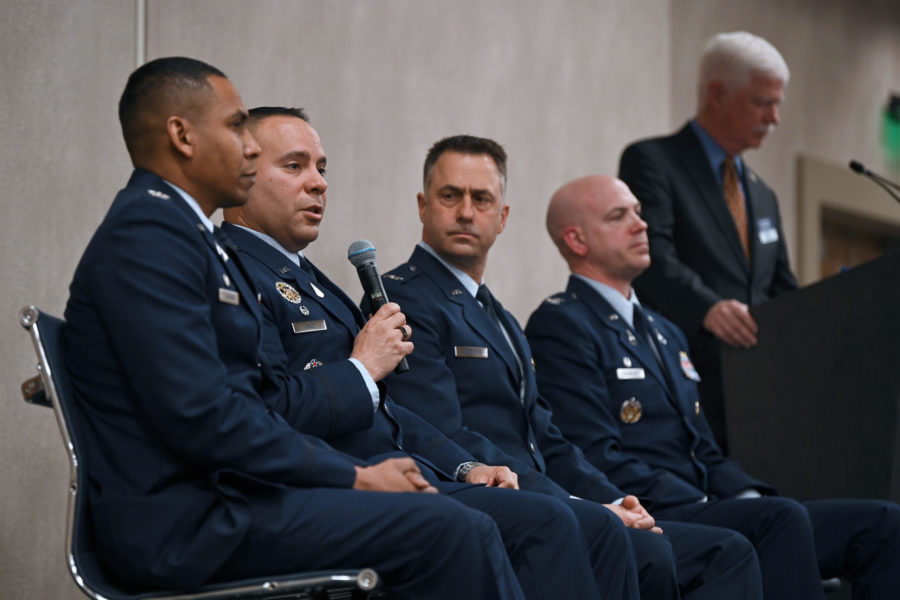AURORA, Colo.—Space Delta 4, the Space Force unit responsible for missile tracking and warning, will take over responsibility for the Joint Tactical Ground Stations from the Army in October, its commander said March 6.
The Army was originally slated to keep the JTAGS mission, even as the Space Force took over other services’ space missions, but last September 2022 it became clear that could change. At the time, Maj. Gen. Doug Schiess, vice commander of Space Operations Command, indicated the two services were in early discussions about transferring JTAGS. The transfer was confirmed in a January release about the Buckley Space Force Base.
Space Delta 4 commander Col. Miguel A. Cruz, speaking at the AFA Warfare Symposium, said the transition is slated for October, expanding Delta 4’s broad portfolio.
“By the time all this coalesces, Delta 4 is going to have orbital sensors, ground-based sensors doing the strategic mission, ground-based sensors doing tactical missions and of course, all the array of antennas around the world that ensure that data transfer goes from one place to another,” Cruz said.
The transfer will also create logistical responsibilities for Space Base Delta 2, the mission support unit also headquartered at Buckley.
“When we look at the JTAGS sites, there’s a level of installation support—what type of infrastructure and, more importantly, parts and being able to sustain that,” said Col. Marcus D. Jackson, commander of Space Base Delta 2. “And so when we look at what’s being transferred over from the Army to the Space Force, … we will establish [memorandums of understanding] with the Army on the requirements for supporting JTAGS representatives on site, being able if you need to store equipment, if you have to store parts, having that as part of the interrelationship with Space Force and the Army. We’re in the process of working and doing that now.”
That work is all part of the operational nitty-gritty of transferring missions across services.
“It’s not like you can flip a switch and say ‘Here you go. Here’s the keys to the new mission and off you go,’” he said. “There’s a lot of planning that goes into transferring a mission into another service, to include the number of people that are going to transfer, how you’re going to train them, the training pipeline, the sustainment activities that goes with that because now money and sustainment responsibility go from one service to another.”
In order for the transfer to proceed smoothly, Cruz added, the Space Force will lean on the “resident expertise” of the Soldiers in the Army. Some will become inter-service transfers, while others will filter out over time rather than leaving all at once.
“It’s not like we’re going to be all Guardians on day one. Actually on day one, we’ll have a number of Guardians—we already have about 14 of them among the various JTAGS detachments—and then gradually transition those Soldiers as their normal PCS cycle ensues. That allows us the opportunity to hit the ground running, but also kind of go with the training wheels as we take that over.”
Further developments at Buckley could follow. Col. Robert J. Schreiner, commander of the Aerospace Data Facility-Colorado at the base, said he “would not be surprised to see some evolution of the mission as we evolve to diverse and proliferated architectures, as we evolve to new and emerging mission sets for our mission partners.”
ADF-Colorado is controlled by the National Reconnaissance Office and doubles as Space Delta 20, working with industry, other services, other government agencies, and allies—highlighting the vast number of organizations that have a presence at Buckley.
“We have 110 other mission partners on site that we care for day in and day out,” Jackson noted.
Another of those mission partners is the Colorado Air National Guard, which is also undergoing changes. The Colorado ANG has had both air and space missions for years now, but two of its units are at a crossroads, said Col. Chris J. Southard, commander of the 140th Wing.
The 140th flies F-16s but is hoping to gain new aircraft like the F-35 or F-15EX before its current fighters are retired around the end of the decade, Southard said. Meanwhile, the 137th Space Warning Squadron operates the Mobile Ground Systems trucks that communicate with the Defense Support Program (DSP) constellation. But with those DSP satellites past their anticipated service life, the squadron is also in need of a new mission.
